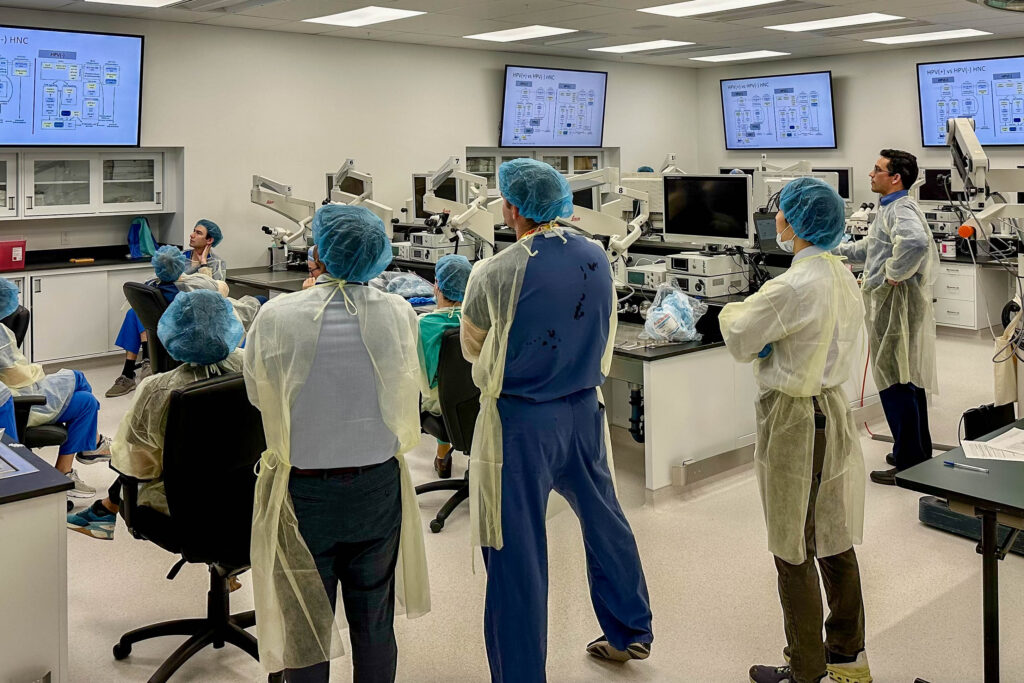Residents in the Department of Otolaryngology at WashU Medicine are quickly realizing the benefits of a change to their core curriculum.
Formerly a weekly, lecture-based didactic session, the core curriculum now includes hands-on dissection in the Multidisciplinary Surgical Simulation Lab, newly constructed in the Farrell Learning and Teaching Center. With its large display monitors and interactive AV system, the simulation lab provides an ideal environment to combine lecture presentations with hands-on cadaveric dissection or training with simulation models.
Facial plastic and reconstructive surgery kicks off fall curriculum
Associate Professor of Otolaryngology and facial plastic surgeon Emily Spataro, MD, implemented three facial plastic surgery modules this fall for the residents: rhinoplasty, browlift/blepharoplasty, and scar revision. She lauded the inclusion of cadaveric dissection as a routine portion of core curriculum and the wonderful facilities and resources, highly effective for resident education.

“Under faculty direction, residents guide each other through portions of the case they wouldn’t normally get to do in the operating room,” she said. “A senior resident can guide a junior resident through opening the nose, then take over to perform the parts of the procedure normally done by the attending surgeon or fellow.”
According to Spataro, the model is impactful on two levels:
- In a low stakes environment, residents acquire technical skills gained by performing portions of the procedures not normally done in the OR on patients.
- Senior residents take ownership of educating junior residents, improving their own understanding of the procedure, developing their teaching skills, and improving the mentoring relationship between senior and junior residents.
Head and neck surgery adds three labs to resident curriculum
Fall lecture topics for the Head and Neck Surgery component included:
- Basics of head and neck cancer
- Laryngeal cancer
- Salivary gland pathology

Each session was held in the simulation lab with cadaveric dissections aimed at instructing residents in proper techniques of neck dissection, laryngectomy (removal of the voice box), and parotidectomy, the removal of part or all of the parotid salivary gland.
“The cadaveric specimens were ideal for this type of training,” said head and neck surgeon Alex Harbison, MD. “That type of support from the department makes a big impact on the teaching of our residents, helping the next generation to succeed!”
Voice and Airway Division wraps up fall curriculum with resident competition
The Voice and Airway Division implemented the first-ever laryngology simulation course to wrap up the fall curriculum. For Division Chief Molly Huston, MD, the course represented a unique and much-needed opportunity for residents.
“Laryngology, due to its nature of being often one-person surgery or awake procedures, is ripe for simulation,” she said. “Surprisingly, there are few simulation experiences in residencies across the country, so it was wonderful to allow the residents a chance to practice, ask questions, and learn in a very low-stakes environment.”
The lab session was a busy tour of several rotations designed to provide hands-on practice with a number of critical techniques, including:

- Laser safety and hands-on laser use: Residents were able to apply laser to pig larynges and to compare the different effects of thulium, KTP, and CO2 lasers. Lasers were provided courtesy of Midwest Stone.
- Microlaryngeal simulation: Silicone vocal folds with lesions in simulated airways allowed residents to practice removal of the lesions using microscopic visualization.
- Transcervical injection: Neck simulation models, 3D printed by Zach O’Connor at the WashU Tech Den provided practice with trans-thyrohyoid and trans-cricothyroid vocal fold injections.
- Throat GOAT: In this rotation, residents worked in pairs to practice foreign body removal using flexible bronchoscopy on a larynx/trachea model. The timed competition crowned residents Jordan Varghese, MD, and Sam Cler, MD, as this year’s Throat GOATs.
Huston anticipates adding to this opportunity every year, making it better and better.
“I am looking forward to seeing who dethrones our current Throat GOATS next year!” she said.
